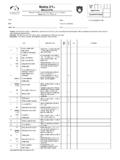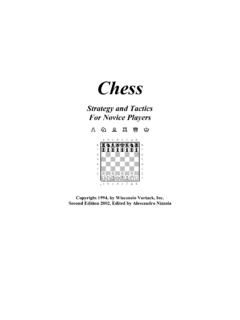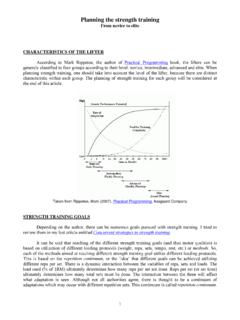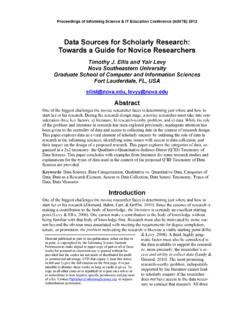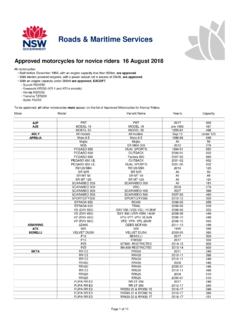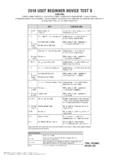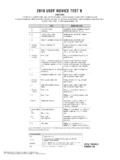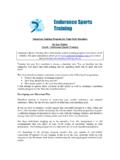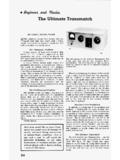Transcription of Novice 2:2 Bridle No. Effective 1/1/14 Judge Position ...
1 Purpose: To confirm that the horse, in addition to the requirement of Preliminary Level, has developed the thrust to achieve improved balance and throughness and to maintain a more consistent contact with the bit Introduces: Leg yield Instructions: To be ridden in a snaffle. All trot sitting or rising unless stated otherwise TEST DIRECTIVE IDEAS Judges Marks (10) Coefficient Total REMARKS 1 A X Enter in working trot Halt, Salute Proceed in working trot Straightness on centreline and in halt; immobility; quality of trot; willing; balanced transitions 2 C MXK KR Track right Lengthen stride in trot Working trot Bend and balance in the turn; moderate lengthening of frame and stride; quality and consistent tempo of trot; willing, balanced transitions; straightness 3 RI Half circle left 10m sitting trot Shape and size of half circle; quality of trot; bend 4 XK Leg yield right sitting trot Quality and consistent tempo of trot; alignment of horse, balance and flow of leg yield 2 5 A Working canter left lead Willing, calm, balanced transition; quality of canter 6 P Circle left 15m Quality of canter.
2 Shape and size of circle; bend 2 7 PM Lengthen stride in canter Moderate lengthening of frame and stride; quality and consistent tempo of canter; balance; straightness 8 Between M & C Develop working canter Willing, balanced transition; quality and consistent tempo of canter 2 9 HXF X Change rein Working trot Willing, balanced transition; quality of canter and trot; straightness 10 A Medium walk Willing, balanced transition; quality and regularity of walk 11 KXH HC Free walk on a long rein Medium walk Reach and ground cover of free walk allowing complete freedom to stretch the neck forward and downward; quality and regularity of medium walk; straightness; willing, balanced transitions 2 12 C Working trot Willing, balanced transition; quality of trot 13 R Before R RP Circle right 20m rising trot, allowing the horse to stretch forward and downward Shorten the reins Working trot Forward and downward stretch over the back into a light contact maintaining balance and quality of trot; bend; shape and size of circle; smooth, balanced transitions 14 PL Half circle right 10m sitting trot Shape and size of half circle; quality of trot; bend 15 XH Leg yield left sitting trot Quality and consistent tempo of trot; alignment of horse, balance and flow of leg yield 2 16 C Working canter right lead Willing, calm, balanced transition; quality of canter 17 R Circle right 15m Quality of canter; shape and size of circle; bend 2 18 RF Lengthen stride in canter Moderate lengthening of frame and stride; quality and consistent tempo of canter; balance.
3 Straightness 19 Between F & A Develop working canter Willing, balanced transition; quality and consistent tempo of canter 2 Novice 2:2 Effective 1/1/14 Arena size 60m x 20m Test Time 6:00 Minutes (from entry at A to final halt) Suggested Draw Time 8:00 minutes Event_____ Horse _____ Horse | Pony (please circle) Bridle No. Judge Position Competitor/Participant Rider _____ Open | YR | JNR (circle) Judge Name _____ Date _____ Novice 2:2 TEST DIRECTIVE IDEAS Judges Marks (10) Coefficient Total REMARKS 20 KXM X Change rein Working trot Willing, balanced transition; quality of canter and trot; straightness 21 HXF FA Lengthen stride in trot Working trot Moderate lengthening of frame and stride; quality and consistent tempo of trot; willing, balanced transitions; straightness 22 A X Down centreline Halt, Salute Bend and balance in turn; straightness on centreline; willing, balanced transition; immobility Leave arena in walk on a long rein at A COLLECTIVE MARKS Paces (freedom and regularity) 1 Impulsion (desire to move forward, elasticity of the steps, relaxation of the back and engagement of the quarters) 1 Submission (attention and confidence.)
4 Harmony, lightness and ease of the movements; acceptance of the Bridle ) 2 Rider s Position and seat; correctness and effect of the aids 2 TOTAL MARKS 350 Judge Signature: _____ Penalties Minus 2 Reason: Minus Total Penalties Course Errors (Cumulative) 1st -2 2nd - 4 (= 6) 3rd Elimination Minus Total Faults FINAL MARK PERCENTAGE 2010 United States Equestrian Federation, Inc. (USEF) for use in Australia only. Reprinted with the permission of USEF. All rights reserved. Reproduction without permission is prohibited by law. This test is modified with the permission of USEF for use by Equestrian Australia. USEF is not responsible for any errors or omissions in the publication or for the use of its copyrighted materials in an unauthorized manner.


